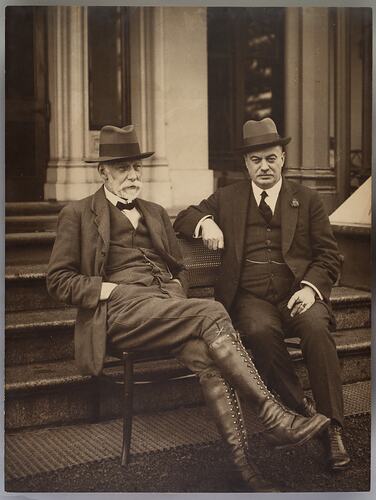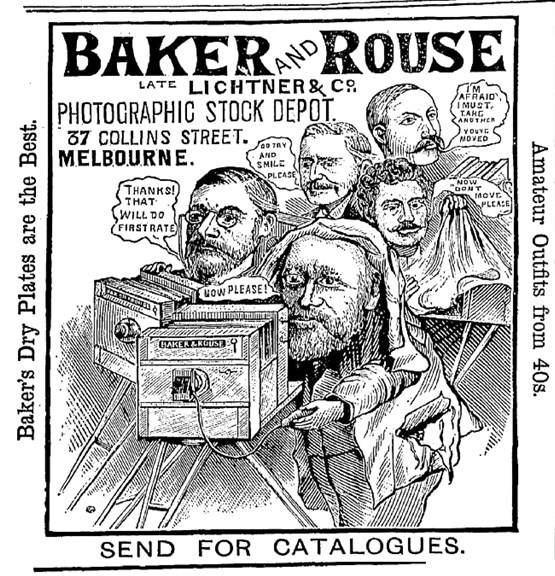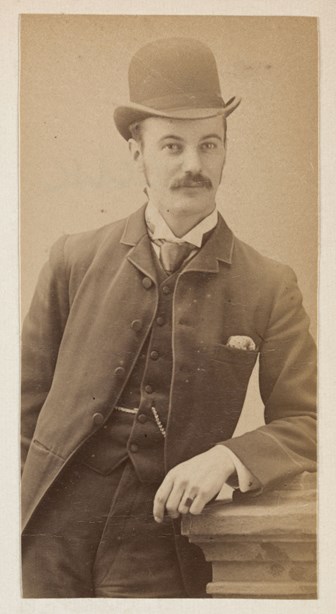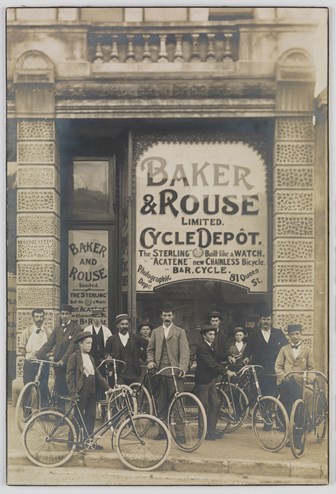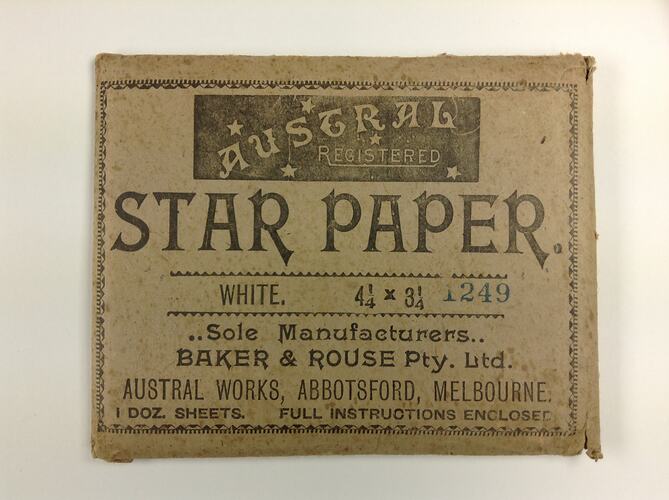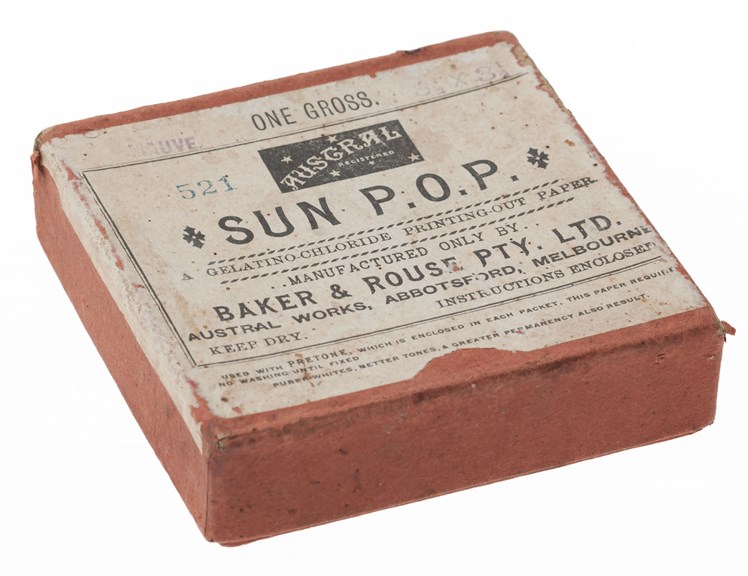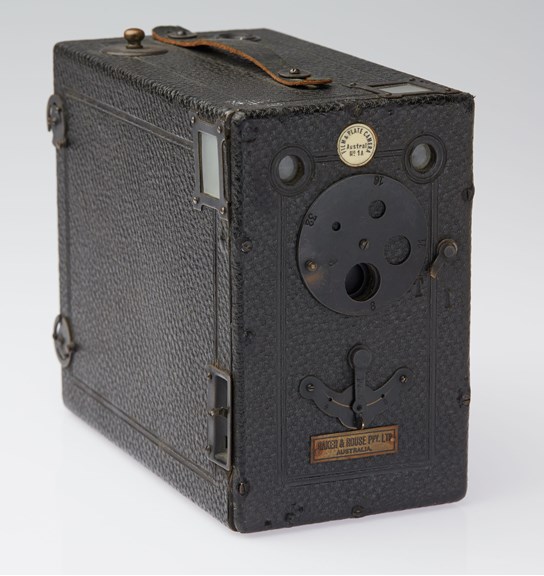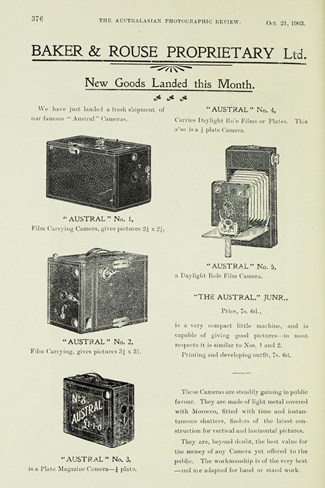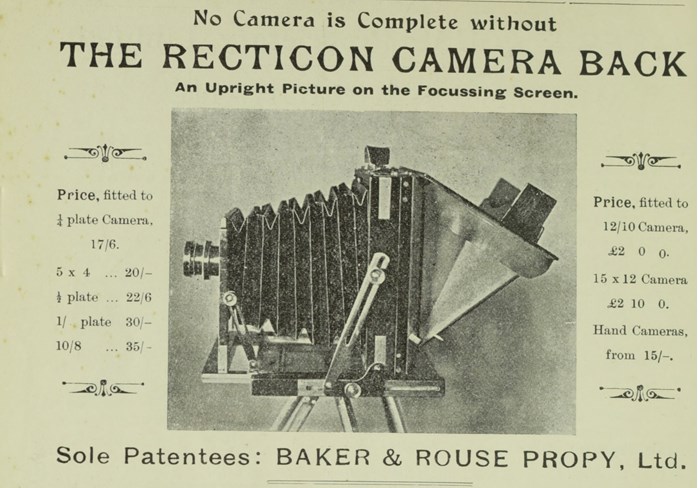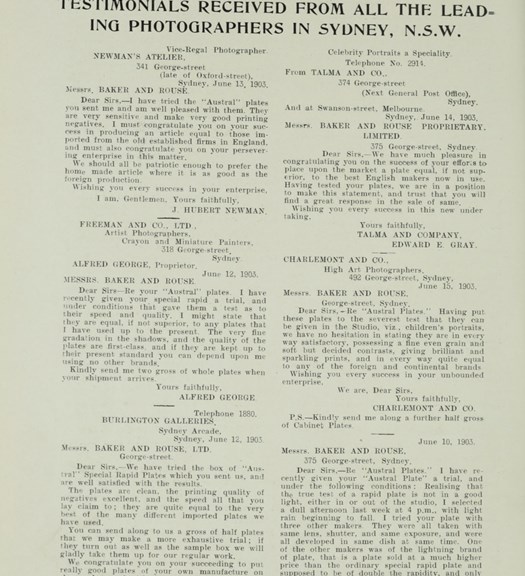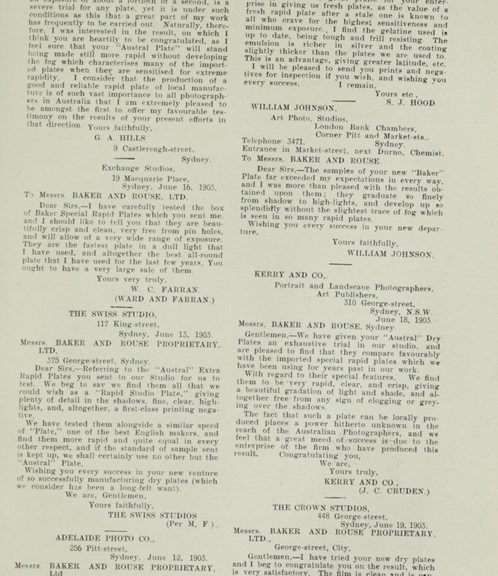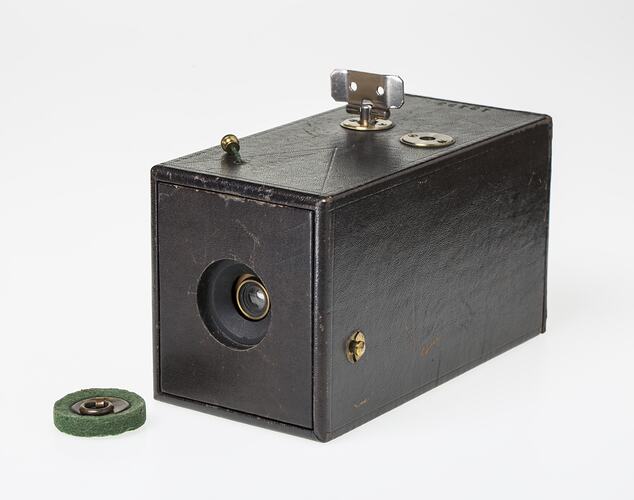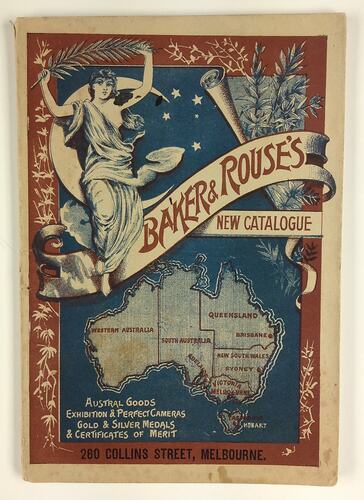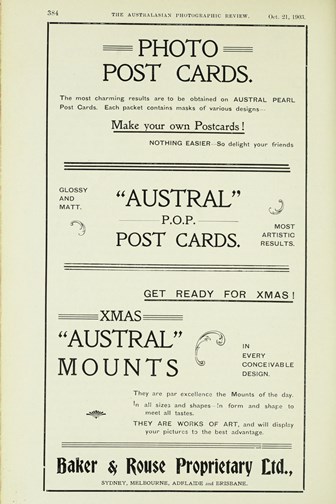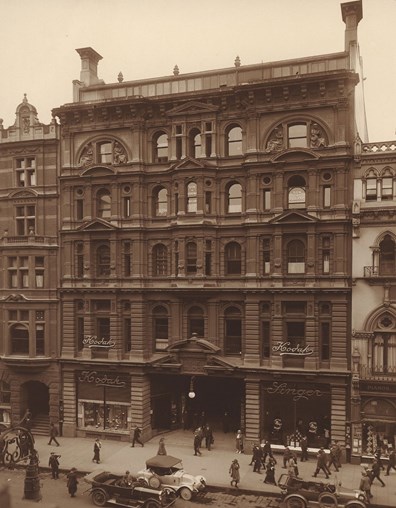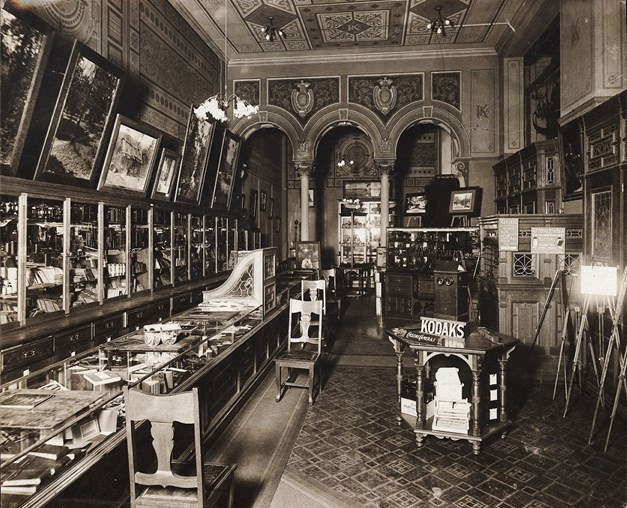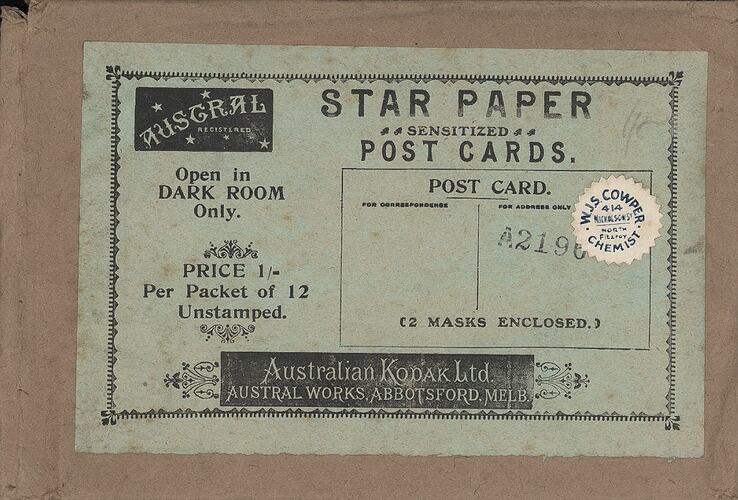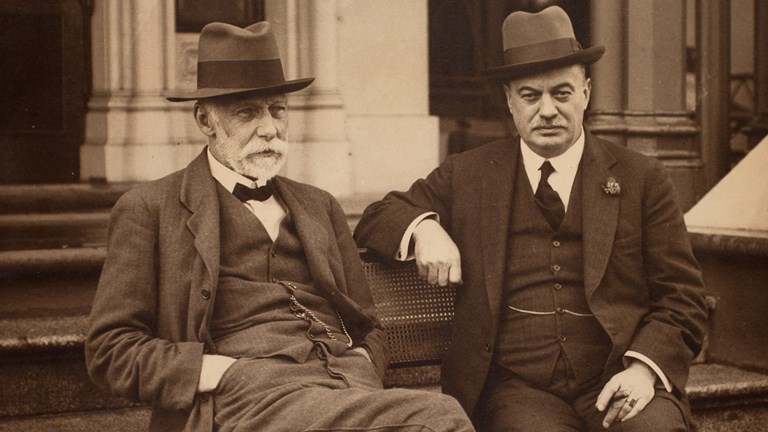
Baker & Rouse
A Successful Partnership
After a successful first few years in business making and selling his photographic dry plates, in 1887 Thomas Baker joined with photographic salesman John Joseph (JJ) Rouse to form a new business named Baker & Rouse.
"During this long partnership he never interfered with me, and I never took any part in the running of the Works. Although we were entirely different dispositions we had only one subject in view, namely the success of the firm."JJ Rouse to George Eastman about Thomas Baker, 1928
A New Business
The Baker & Rouse commercial partnership brought a manufacturer and a retailer together.
The new business was aimed at selling Baker’s products, as well as imported photographic goods. Thomas Baker retained separate ownership of his own manufacturing business, which he now branded T. Baker & Company.
A Retail Store
Baker & Rouse’s first enterprise together was opening a retail store at 37 Collins Street East in the Melbourne CBD in May 1887.
The store had previously been run by Lichtner & Co, who had outlets in both Melbourne and Sydney and promoted themselves as having the “largest photographic stock” in the Australian colonies.
Lichtner & Co had started advertising the sale of Thomas Baker’s dry plates in March 1887.
Two months later, Thomas Baker & JJ Rouse had bought out the business.
JJ Rouse is believed to have been the Lichtner & Company store manager at this time and it appears that he saw the potential in Thomas Baker’s Australian made products, going so far as to buy into Baker's business to have a share of the profits.
Award winning Exhibitors
Just a year after their business was established, Baker & Rouse won a First Order of Merit award at the 1888 Centennial International Exhibition.
This was held in Melbourne between 1 August 1888 and 31 January 1889. The Exhibition celebrated 100 years of British settlement, and its exhibits, featuring culture, commerce, trade and industry, attracted over two million visitors.
Baker & Rouse were exhibitor #164 and won their award for a colonial made camera in Class 12 - Photographic Proofs and Apparatus, in the Photographic outfit section. This was supposedly “the first and only medal given for colonial made cameras” in Australia.
Their display was situated on the left-hand side of the concert room at the Exhibition Building, and featured their colonial made camera, which was noted as being extremely light, weighing only four pounds.
“some splendid specimens of cameras, made to their own order. These cameras are of exquisite workmanship, they … compare favourably with those of the most celebrated English makers”.Melbourne Punch
The company also won a First Order of Merit award as agents of Eastman and Company, for photographs, which were described as bromide paper photos and opal plate photos.
An Australia Wide Network of Branches
Baker & Rouse soon found great success. They became Australia’s premier photographic retailer, with branches around Australia.
The new business grew quite fast. In October 1887, Thomas Baker advertised in the South Australian press for an agent in that state to sell “Baker’s photographic plates and other manufactures on commission”.
By December of that year, Baker & Rouse were advertising that they had premises in Adelaide, at 69 Rundle Street.
Branches in Sydney and Brisbane soon followed. Like their first store, both of these were also takeovers of former Lichtner stores. Shortly after, a branch was opened in Hobart too.
1887 69 Rundle Street, Adelaide
1891 375 George Street, Sydney
1891 Elizabeth Street, Brisbane
1892 125 Liverpool Street, Hobart
A Collins Street Empire
The company aimed to be the best and biggest photographic retailer they could be, and bought out their competition whenever they could.
They also moved around Collins Street, always seeking the best location and securing more retail space as their business grew.
1887 37 Collins Street East, Melbourne
1889 256 Collins Street, Melbourne
1893 260 Collins Street, Melbourne
1905 284 Collins Street, Melbourne
Products and Patents
From the late 1880s onwards, Baker & Rouse were known for their popular range of dry plates, photographic papers and mounts which were all made at the Austral Works in Abbotsford. After experimenting with making cameras locally, these were eventually imported but were still made according to Baker & Rouse’s design.
Photographic Papers
Baker & Rouse were selling a variety of photographic papers, including: POP papers by at least the 1890s, Austral bromide papers from 1890, Austral Sun gelatine chloride printing out paper and Austral Star glossy bromide paper from 1894, Austral Pearl platino-bromide paper and Simplex gaslight paper from 1896.
Advertising and editorials focused on the fact that Austral papers were always fresh compared to product that was imported from England or America.
In August 1895 Thomas Baker, applied to have a 15% import duty placed on sensitised photographic paper. He was trying to protect his young business from discounted imports. He noted that at this time he employed 33 staff, “at above the average rate of wage”.
Cameras
Baker & Rouse had been quick to get into the camera market. They exhibited and won a first prize for their colonial made camera in 1888.
In 1895 the company advertised that it had a Camera Works in Wellington Parade, East Melbourne. However, the Camera Works was a short-lived venture and Baker & Rouse imported their cameras after this.
In 1903 they sold a range of at least five Austral cameras, which were built to their order. No 1 and No 2 cameras were roll film box cameras, while No 3 was a plate magazine box camera. No 5 camera was a folding camera.
Baker & Rouse had more luck with innovative camera parts. In 1900 Baker registered a patent for a Recticon camera back to give “an upright picture on the focussing screen”, which found a market amongst Australian photographers.
Dry plates
Although Thomas Baker’s dry plates had a strong reputation, around the turn of the century they appeared to have issues with quality.
After installing a new improved factory setup specifically for dry plates in 1903, Baker & Rouse sent their new plates for free to a wide range of professional photographers around Australia to trial them.
Their testimonials were then featured in the magazine that Baker & Rouse published, the Australasian Photographic Review.
Film
Thomas Baker experimented with making film and in 1902 introduced an Austral cartridge film to compete with the well-known Eastman Kodak film. The Australasian Photographic Review remarked that:
“It will surely be a boon to the Australian amateur to be able to rely on getting fresh films within a few days or hours from the makers.”
Cameras, Magic Lanterns, Phonographs and Binoculars
As well as making their own products, Baker & Rouse imported a range of products from England, America and Europe and were up to date with photographic innovations, or ‘novelties’ as they were described at the time.
They became the sole Australian agents for some products. For instance, in 1887, their first year of trade, Baker & Rouse became agents of the Eastman Company of New York, USA, and sold George Eastman’s revolutionary new paper-backed ‘stripping’ roll film, showing that they were at the cutting edge of the industry.
In 1888 Baker & Rouse imported and sold the revolutionary Eastman Kodak ‘detective’ camera that took 100 exposures on roll film. In 1889 Baker & Rouse claimed to have the largest collection of detective cameras ever exhibited out of London.
Thomas Baker argued that the company relied on keeping a broad range of stock to remain viable, due to the duty on sensitized papers in Victoria.
In the 1890s and early 1900s their extended product range focused strongly on the ‘magic lantern’ line of products, including projectors and lantern slides.
In the first decade of the 20th century the firm evolved to the latest popular music records and players, including the Edison phonograph and Columbia graphophone, as well as optical products such as binoculars, telescopes and microscopes.
Upgraded Facilities
Baker & Rouse continually invested in new equipment to maintain their high quality in production and also remain competitive.
Around 1895 new equipment was purchased for manufacturing the company’s popular lines such as Austral Sun, Star and Bromide papers, lantern plates and artistic mounts.
In June 1903 it was reported that a new building had now been opened, as a “fully equipped and up-to-date photographic dry plate factory”.
Over 100 staff were employed at the Baker & Rouse Austral Works in 1905, producing lantern plates as well as bromide paper, mounts, postcards and printing out papers.
Philanthropy
Baker & Rouse were active in philanthropic activities. They supported the growing community of photographers by donating photographic products, giving discounts on purchases, providing prizes for photographic competitions and supporting photographic education.
This generous sponsorship not only brought the company status, it also brought in new customers and trained them - and ultimately sold more product.
Baker & Rouse also supported children’s and women’s charities. They provided phonographs for music and magic lantern shows for entertainment at fundraising fetes.
A Change in the Company Structure
In 1896 Baker & Rouse amalgamated with Thomas Baker’s manufacturing business, T. Baker & Company, to form Baker & Rouse Limited.
JJ Rouse now had a stake in both the retail and the manufacturing arms of the business, as Thomas Baker always had.
A year later, in June 1897, the company became known as Baker & Rouse Pty Ltd and the Austral Laboratory became the Baker & Rouse Laboratory.
Kodak Agents
In October 1904, Baker & Rouse bought the Australasian rights of Kodak Limited, and its other agencies such as Rochester Optical Company, Century Camera, and Nepera, Velox and Aristo papers.
They also bought out the Kodak Limited shop fittings, stock and leasehold in the Block Arcade, at 284 Collins Street. Baker & Rouse held a moving sale at their 260 Collins Street premises on Friday 28 April 1905 before relocating to the larger, more up-to-date and well positioned former Kodak Limited store.
A Kodak Merger
On 7 August 1908 the manufacturing component of the Baker & Rouse Pty Ltd business was acquired by Eastman Kodak, with the new operation known as Australian Kodak Limited.
Thomas Baker and JJ Rouse were appointed as the founding directors.
The retail arm of Baker & Rouse, with its network of national branches, was now a subsidiary of Australian Kodak Limited, but it continued to operate under its own name.
Baker & Rouse now sold Australian made Kodak products as well as their own Austral brand products, allowing the well-loved company to stay in the public consciousness for some time yet.
References
The Australasian 28 May 1887, p.45; 23 June 1900, p. 35
The Australasian 12 February 1887, p. 45, 12; March 1887, p.46; 4 June 1887, p.46
Australian Photographic Journal, September 1886, p.19; September 1895, pp. 61 – 62; April 1896 p.4
Australasian Photo Review, September 1895 p.4; 23 April 1900, pp.26-27, 125; August 1902, p.233; 25 April 1905, p.122-123, 125, 151-152,154; 21 September 1908, p.331; 15 November 1930, p.532
Age, 4 September 1888, p. 4; 26 January 1889, p.16; 22 August 1895 p.7; 18 June 1900, p.9
28 April 1905, p.2
Argus, 26 March 1889, p.6; 26 Nov 1887, p.19; 27 May 1895 p.8; 27 August 1895 p.7; 27 November 1897, p.16; 14 March 1902, p.6; 12 March 1904, p.20
Australian Star, 25 April 1903, p.7; 23 Dec 1907, p.6
Baker & Rouse Catalogue p.6, 1890, SLV, http://handle.slv.vic.gov.au/10381/244312
Ballarat Star, Thursday 11 July 1895; 15 July 1895 p.1
Brisbane Courier, 19 Dec 1906, p.6
Daily Telegraph, 19 April 1905, p. 12
Herald, 10 June 1892, p.4; 12 January 1895, p.2; 1 Sep 1903, p.2
Geelong Advertiser, 9 August 1892 p.4; 15 Dec 1893 p.2; 20 May 1893 p.2
Victorian Government Gazette 16 June 1900; 22 June 1900 p.2333; 11 June 1897, p.2464; 22 May 1896, p2153; 22 May 1896, p.2208; 11 June 1897, p.2464
Leader, 1 Jan 1901, p.104
Melbourne Punch, 9 August 1888, p. 21; 15 December 1887, page 11; 22 Dec 1887 p.12; 1 November 1888, page 21; 12 July 1900, page 6; 6 Sep 1900, p.8; 9 April 1903 p.15; 9 July 1903 p.12; 10 September 1903, p. 10; 10 March 1904, p.23; 13 April 1905, page 15; 11 May 1905, page 11; 18 May 1905, page 27
Mount Alexander Mail, Saturday 20 July 1889, p. 3
Museums Victoria Collection, TL 64825, Catalogue - Baker & Rouse, Baker & Rouse's New Catalogue, circa 1895; The History of Kodak in Australia, Nigel Beale (unpublished, 1983)
North Melbourne Courier and West Melbourne Advertiser, Friday 17 July 1896, p. 2
Sands & McDougall Directory, 1889; 1891, 1894; 1897; 1900, 1905
Sunday Times, 19 April 1903 p6; 13 Dec 1903, p.14
Sydney Mail, 21 Oct 1903 p.1025; 23 March 1904, p.709
University of Rochester, Kodak Historical Collection, #003, Series II, Corporate Papers National & International, Subseries 10: National and International Kodak Locations, Box 59: Annual Reports and Data, Folder 9: Information on Foreign Companies (File 1 of 3), Reports
